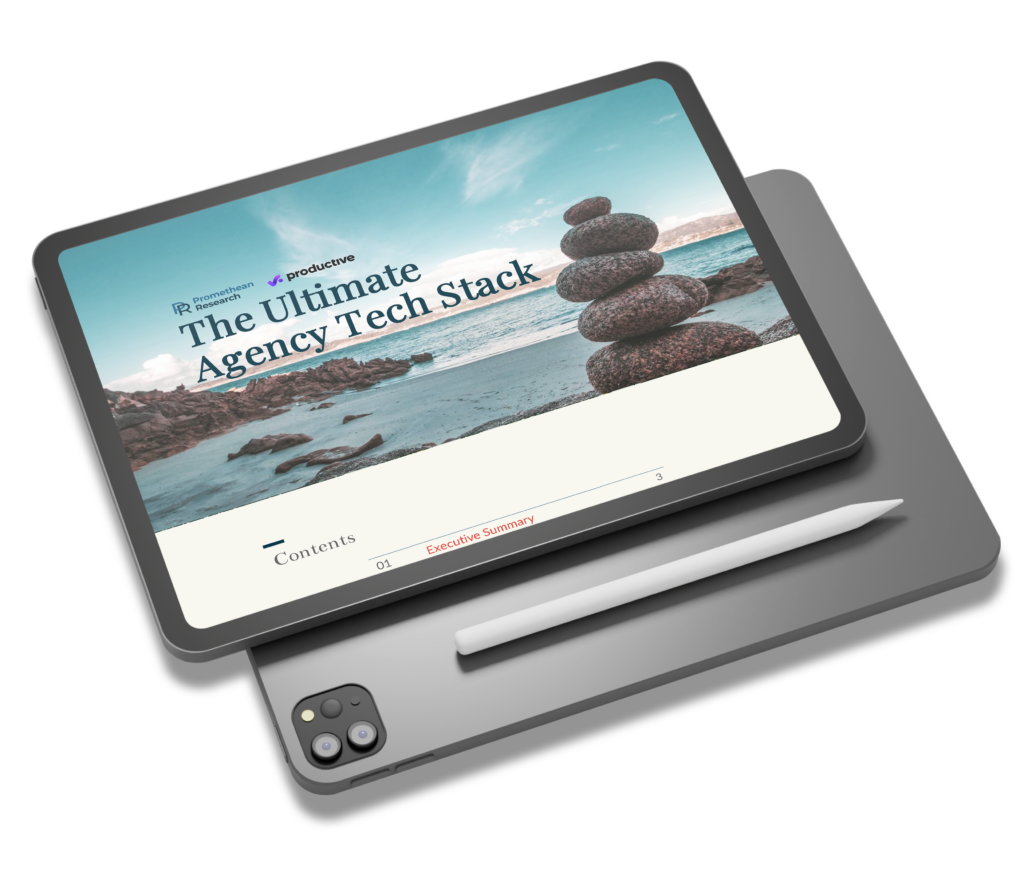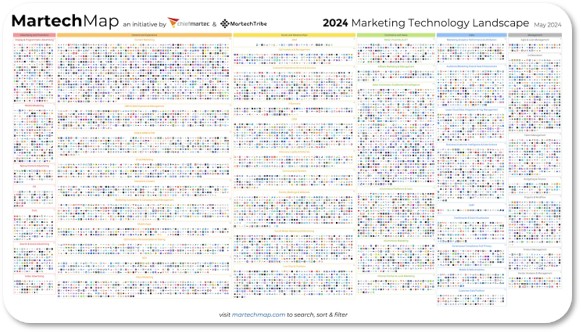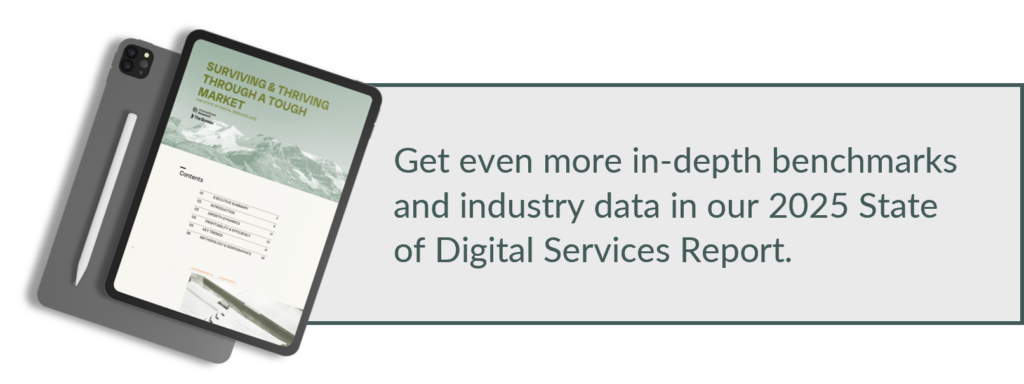Executive Summary
As agencies grow, their tool needs evolve.
This evolution is primarily driven by changes in knowledge transfer and process sophistication. The key takeaway from this research is that an all-in-one agency management suite is the right call for almost every agency. Between the individual tool savings and the ability to easily understand the agency’s health, these systems have become robust enough that they’re quickly becoming table stakes in the industry.
For those who wish to hold out on adopting an AIO agency management platform, there’s the component software route. While there are thousands of tools available to the modern digital agency, we will be focusing on the ones that have been recommended the most by digital agency leaders in our research and network.
Growth & Tooling
Sub-10 FTEs
As agencies grow, their tool needs evolve.
Some of this evolution is driven by increasing sophistication levels. As shops get bigger, their processes and procedures tend to become more intricate. Tools that solve a singular challenge for a small shop might not be able to handle the nuanced challenges of a larger agency.
Another significant driver of evolving tool needs is knowledge storage and transfer.
When a shop is small, <10 full-time employees (FTEs), it’s easy for everyone on the team to engage in 1:1 communication about revgen, production, or support-related topics. Most of the information that exists within the agency is housed within the individuals who work there.
Beyond 10 FTEs
Change in Communication Complexity as Agencies Grow

Source: Promethean Research
Once agencies grow past about 10 FTEs, this all changes. Their internal communication abilities become dramatically more complex, employee turnover weighs on internal knowledge, so it needs a place to live more permanently, and leadership requires more detailed metrics to manage the health and growth of the agency.
As agencies grow even further, knowing what and where information exists becomes increasingly difficult. Simply evaluating the lines of communication that exist at small agencies vs. large agencies illustrates this challenge. Proper tools help agencies create, store, and transfer knowledge; good ones will scale as the agency grows.
Agency Metrics & Where to Find Them
Actual Utilization Rates as Showing By Productive
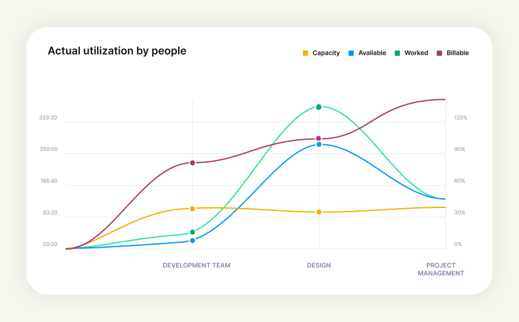
Source: Promethean Research and Productive
The metrics section is a place where we see a lot of differentiation between agencies that are executing on a higher level and those that are struggling. In our strategy work, we have a Request For Information form that we send over at the beginning of the engagement. This form asks for many items relevant to crafting a strategy and a decent number of them are around metrics. The high-performing agencies can easily provide all the base metrics and more. Those that are struggling either take a while to find the metrics or don’t have access to that kind of data at all. If data about your agency’s health is difficult to come by, it makes it impossible to quickly adapt to changing conditions like recessions, pandemics, the advent of AI, etc. Quality tools give you greater visibility into your agency’s metrics.
Beyond metrics, good tools also facilitate necessary agency motions better than others. We see this reflected in their popularity both in our surveys and on software review sites. Tools exist to make life easier. Your team shouldn’t be fighting them.
The goal of this guide is to narrow down the vast list of tools that are available to the ones that we’ve seen make real differences at digital agencies.
All-In-One Agency Management
AIO Agency Management
We won’t bury the lead; an all-in-one (AIO) agency management software solution is the right call for almost every agency above 10 FTEs. The ease of having everything in one place unlocks the ability to use your agency’s data to make better decisions across the board.
All-in-one agency management solutions offer significant advantages over piecing together various component software. They provide cost efficiency, integrated functionality, ease of use, optimized performance, centralized support, and enhanced collaboration. While there are challenges, such as the initial learning curve, unused features, and single-vendor dependency, the benefits often outweigh these drawbacks. For digital agencies aiming to streamline operations and enhance productivity, adopting an all-in-one management solution should be a real consideration.
Integration
All-in-One Solutions offer a wide range of integrated features, such as project management, financial tracking, time tracking, client portals, and collaboration tools, all within a single interface. This integration ensures that all necessary tools are readily available and work seamlessly together.
While individual tools may excel in their specific areas, they often lack the seamless integration of an all-in-one solution. Users must manually transfer data between systems, increasing the risk of errors and inefficiencies. Tools like Zapier can reduce this, but those systems are still more fragile than an AIO.
Investment, Support & Resources
From our survey work, we find that digital agencies spend about 4% of their revenue on tools. For a 10FTE shop, this comes out to $64k/yr on average. Cost is a real consideration for these all-in-one tools, but they need to be examined within the context of what they’re replacing.
As we’ll see in the Component Software section, AIOs can often provide a more complete agency management solution for less than the costs of the component software they replace. Initial setup costs associated with onboarding and training are common and need to be considered when selecting an AIO.
Additional savings vs. component software come from reduced administrative overhead. AIO solutions come with centralized billing and fewer vendor relationships, reducing the amount of administrative management needed.
No software works perfectly 100% of the time. Speedy and effective resolutions can make all the difference in the world. Access to comprehensive support services from a single provider can resolve issues more efficiently than bouncing between vendors to uncover the source of the issue and then waiting for a solution.
Agency AIO platforms also tend to publish extensive agency-focused resource libraries, training materials, and community forums that make learning and implementing best practices easy.
Common AIO Challenges
While the argument for AIOs is strong, it’s not without some caveats.
Initial Learning Curve
Despite their user-friendly design, the breadth of features in all-in-one solutions can initially overwhelm new users. Comprehensive training and support are essential to help teams adapt and fully utilize the platform. Most AIOs will require significant training and onboarding, requiring both dollar and time investments from agencies adopting them.
Unused Features
We have heard multiple leaders say their teams use 70-80% of their AIO but haven’t taken the time or aren’t interested in taking full advantage of all the features. This is especially true at smaller agencies.
Single-Vendor Dependence
Relying on a single provider for all management needs can pose risks if the vendor experiences issues or if the solution does not meet evolving business requirements.
AIO Options: Productive
Sample Screens from Productive
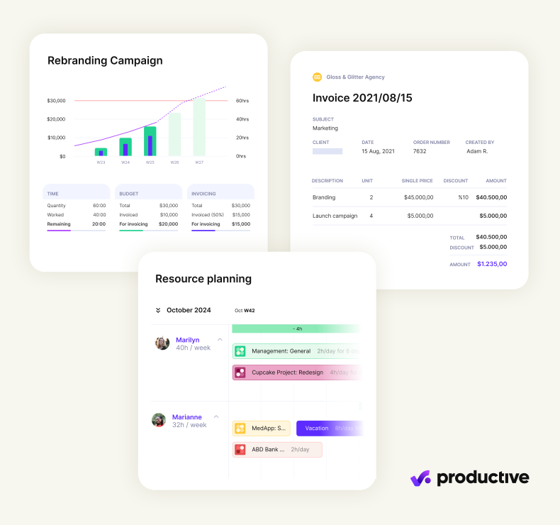
Source: Promethean Research and Productive
Multiple agency leaders we spoke with stated that implementing Productive has been transformative for their firms.
Leaders specifically call out the software’s ability to consolidate agency management tasks from a number of other software sources, including homebrewed ones, into a single source of truth. The communication, reporting, and forecasting capabilities that this enables makes it easy for leaders to understand what’s going well and where their attention is needed.
The software combines a number of features into a single agency management platform. It includes Customer Relationship Management, Project Management, Resource Management, Profitability and Financial Metrics, and Invoicing. Pricing starts at $9/seat/month, but most will find value in upgrading to the “Ultimate” tier.
A note on our sponsor: Productive sponsored the creation of this guide. They had no input over the content, research, or opinions expressed in this document.
AIO Options: Parallax & Teamwork
Parallax is a resource management and capacity forecasting platform, a quasi-AIO solution that’s another good option for agency management software. Agency leaders have specifically called out their integration consultants for making the onboarding process simpler. In contrast to Productive and Teamwork, Parallax has chosen an integration-style approach focusing on integrating with other tools for a more seamless onboarding and better cross-team adoption. This reduces the cost-saving benefit as agencies will still need other tools in conjunction with Parallax to run their shops. Parallax doesn’t publish pricing on its website but only charges per billable resource.
Teamwork has a similar feature set to Productive and Parallax, but agency leaders were less enthusiastic about its reporting capabilities. Teamwork appears to be the lowest-cost option of the three, but that pricing excludes “add-on” features that, when included, raise the cost significantly.
There are other software solutions that combine many aspects of business management into a single platform, but many of the more generic ones lack an understanding of agency operations or needs.
Parallax & Teamwork
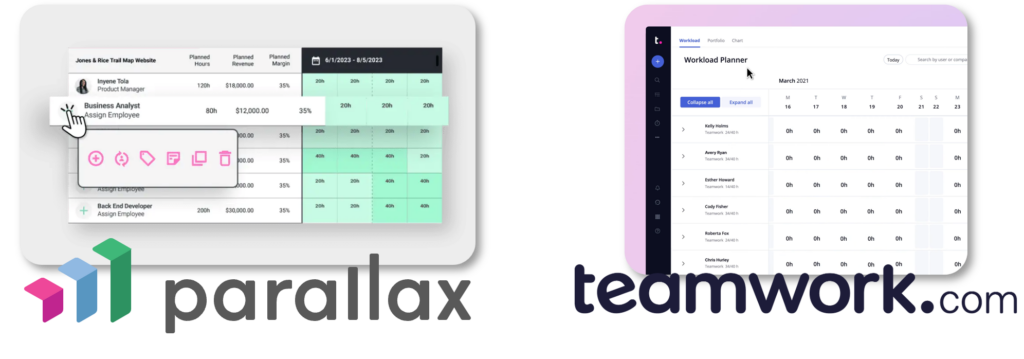
Source: Promethean Research, Parallax, and Teamwork
Component Software
Narrowing The Options
If you don’t go the all-in-one agency management route, there are seemingly infinite options out there. The number of martech options alone is daunting. Each dot on this market map is a logo… Most of these are more generalist software that can be plugged into any business vs. having an agency-specific focus.
The core functions that agencies look to solve with these software solutions exist in Revgen, Production, and Support. Revgen software mainly consists of marketing automation and customer relationship management software. We’re limiting our discussion of production software to project management and issue tracking. The various tools available to help perform software development, digital marketing, and design are beyond the scope of this guide.
To identify the most commonly used, endorsed, and combined tools, we evaluated the various responses to our tools surveys and combined that with what we’ve seen in our strategy work with agency clients. These evaluations are appropriate for digital agencies in the 10-100 FTE range and reflect how agencies are actually using the tools. Most of these tools offer significantly more features than the specific function they fall into, but we found that agencies will tend to use them primarily for a singular purpose. This may differ from how the various tools position themselves.
Revgen Software
Top Revgen Software

Source: Promethean Research
Marketing Automation
HubSpot is the clear leader in the marketing automation space. It’s both the most popular and, anecdotally, the most well-liked. It’s also one of the more expensive options as you add on their marketing, sales, service, content, etc. This tool can quickly grow beyond marketing automation, but a dedicated agency tool may make more sense at this stage.
Customer Relationship Management
Pipedrive has built out a broad suite of sales-enablement features that agency leaders seem to love. It can do some advanced workflows, but even the base setup can give leaders a solid view into their sales pipelines. Leaders praised its simplicity.
Production Software
Top Production Software
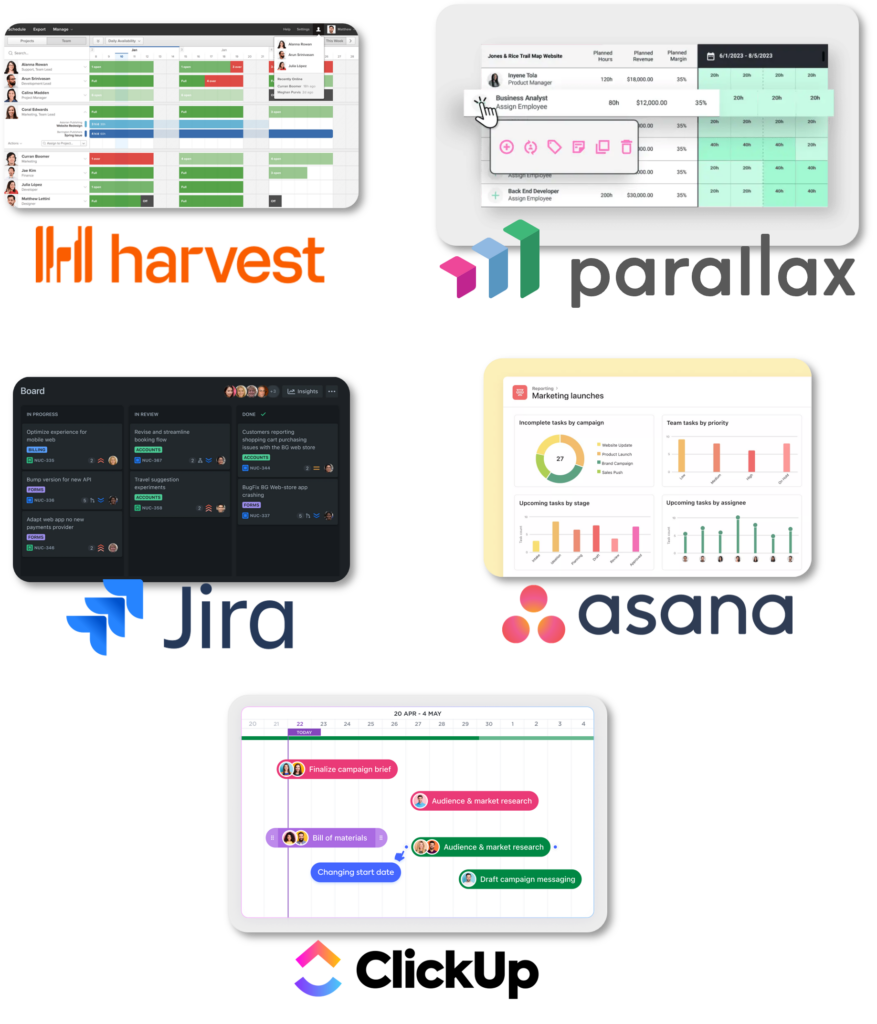
Source: Promethean Research, harvest, parallax, Jira, asana, and ClickUp
Capacity Management
Parallax and Forecast (Harvest) are both great (and popular) options for capacity management. While Parallax does a lot more than just capacity management, its primary benefit lies in providing insight into past, present, and future utilization, revenue, and project health.
Project Management
Jira and Asana are pretty evenly tied as far as agency project management software is concerned. Jira tends to show up more in the more dev-focused shops, while Asana is more popular with the marketing and design agencies. Leaders noted that the Jira setup and implementation process can be significant, and they often seek out expert implementation consultants for this step.
Issue Tracking
Jira and ClickUp are the big players in issue tracking. Again, Jira is more popular with the more dev-focused agencies, while ClickUp is more popular with the marketing shops.
Support Software
Top Support Software
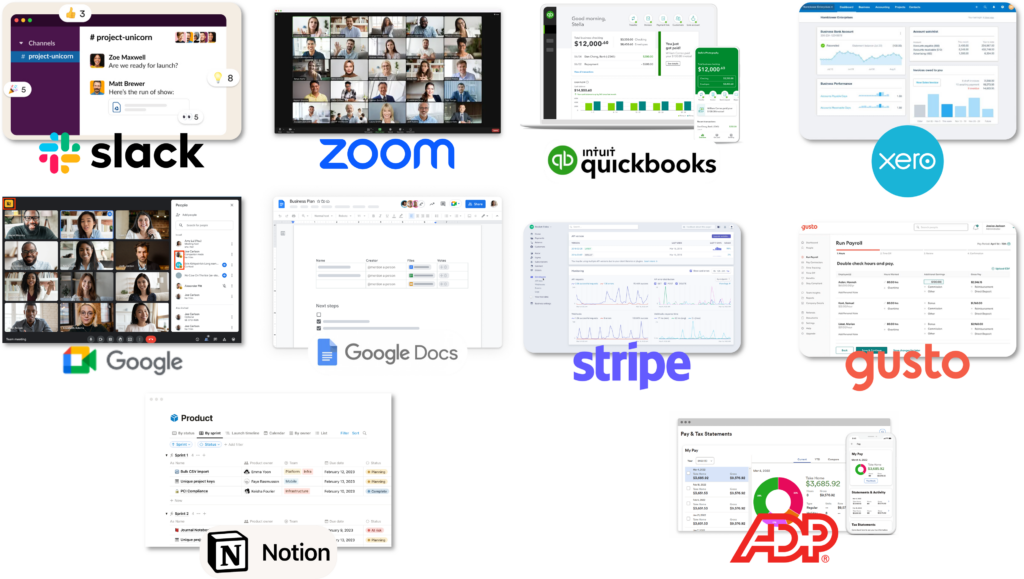
Source: Promethean Research, quickbooks, xero, stripe, gusto, and ADP
Finance and Accounting
Quickbooks is one of the most common accounting solutions but Xero has become more popular in recent years as agency leaders report frustrations with Quickbooks. The main thing to consider here is what your accounting/tax/bookkeeping team is familiar and comfortable with. Both seem to be sufficient for running a digital agency, but leaders generally frame Xero in a more positive light.
Payment Processing
Stripe is the clear winner here. It’s the most versatile and feature-rich processor that developers can integrate into just about anything. It’s rock-solid, and they’ve consistently released innovative features over the years.
Human Resources
Gusto received high marks from many agency leaders for simplifying payroll, but issues with state-specific withholding were more common than one would like. ADP is used more by larger shops who praise its reliability.
Communication
Slack is the most commonly used communication software in the agency space. Real-time communication is still dominated by Zoom with a growing contingent of shops adopting Google Meet. After asking multiple leaders about why they chose one or the other, it seems to come down to personal UX/UI preferences more than any specific capabilities.
Internal Knowledgebase
While many agency leaders use Google Docs for their internal wikis, those who use Notion seem to love it. They specifically call out its versatility; some have built out entire workflows beyond simple operating procedures within the software.
More articles
New Agency Research: Digital Agencies Face Stiff Headwinds in 2025 After a Tough 2024
State of Digital Services 2025 Executive SummaryDigital agency growth stabilized in 2024 but varied by size. Studio shops returned to long-term growth levels, Small shops maintained slow but steady gains, and Medium and Large agencies experienced mild contractions for...
Agency Benchmarks for Assessing Fragility
Benchmarks to Tell When an Agency's Running Hot It isn’t easy to tell when an agency’s running hot. It’s especially difficult when revgen’s covering everything up. We saw this in 2023. The revgen tide receded, and the bony wreckage of nasty agency metrics littered the...
Stabilizing Digital Agencies With & Without Benchmarks
The easiest way to identify issues at an agency is benchmarking. It’s one of the first steps I take when building growth strategies because it tells me where to dig deeper. Here’s what I evaluate, some questions I ask, and some notes on implications: Revgen Revenue...
Our latest insights on running digital agencies
Exclusive research opportunities, thoughts, and advice on the digital agency industry every two weeks.

"Best / most valuable updates from anyone in ages. I get hit up soooooo much, keep this kind of newsletter / value up."
Wil Reynolds
CEO, Seer Interactive

